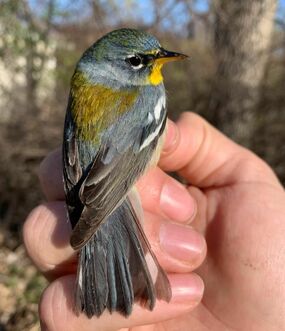Enjoying our blogs?Your support helps BSBO continue to develop and deliver educational content throughout the year.
|
|
Well, after a week of raising our boardwalks out of the drink, last week we were finally ready for the research crew and volunteers to enter the marsh and officially commence banding operations. After being in the marsh for a week prior, we already had an idea of the progression of migration and the species we would catch. But we’ve also had some surprises. This season, more than any in recent memory, has been heavy with Blue-gray Gnatcatchers and we’ve been able to band quite a few. Part of this has been the wind and rainy weather driving them down from the canopy and into the range of our mist nets. Speaking of wind, we’ve also captured an American Kestrel and Sharp-shinned Hawk, who on windy days get forced down from the skies and in range of our nets. As the third week of April began to wane, and Golden-crowned Kinglets and Brown Creepers stopped making appearances, we were in the right time frame to catch some early overflight migrants. These are migrants that typically breed farther south in Ohio, but occasionally get caught up in the overnight winds, overshooting their intended destinations and landing in the lakeshore marshes. Of this group of migrants, we were able to catch a couple of Louisiana Waterthrushes, a Prairie Warbler, and a Pine Warbler (species that are fairly infrequent at the station).
Even though we were catching birds in the double digits, our first real good day of migration came on Tuesday April 23, when winds shifted to the southwest and we had our first 100-bird-day. With this shift, it was almost as if we were in a whole new marsh! We had our first encounters with Eastern Whip-poor-will, Blue-headed and Warbling Vireo, Scarlet and Summer Tanager, Yellow Warbler, Ovenbird, Hooded Warbler, Northern Parula, and Swainson’s Thrush. And not too long after this we also banded our first Gray Catbird for the season. As random as migration may appear, through years of research by BSBO, we’ve been able to identify the pattern of migration through the region, and establish when and which species will arrive. This pattern-knowledge is further strengthened by an understanding of how weather affects bird movement. Using this combination we are pretty accurate with our predictions and have a good idea of what to expect each day we head in to the marsh. Thus, we were pretty sure (ok… we knew) that Tuesday was going to be a good day. What’s neat about this understanding is that it doesn’t take away from the magic of migration in any way. Understanding the factors that drive birds and being able to predict their arrivals and departures reveals a pattern of the natural world, making the spectacle that is migration even more fascinating and awe inspiring!
As we come to the close of April we are hoping that the old saying is true: "April showers bring May warblers." We have had quite a few days of rain and wind hammer northwest Ohio, and are interested to see how persistent northerly winds have affected the progression of migration through the region (especially as we head towards BSBO's Biggest Week In American Birding). Current weather forecasts indicate that Wednesday and Thursday, the 1st and 2nd, could be suitable days for migration; bringing in more Yellow Warblers, Prothonotary Warblers, and Swainson's Thrushes, among others.
0 Comments
Your comment will be posted after it is approved.
Leave a Reply. |
AuthorsRyan Jacob, Ashli Gorbet, Mark Shieldcastle ABOUT THE
|




